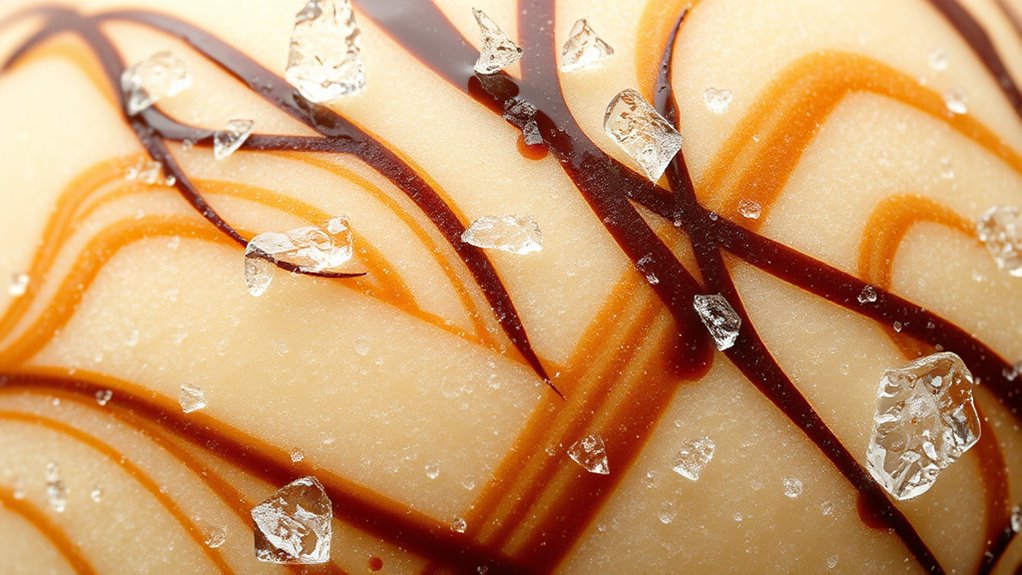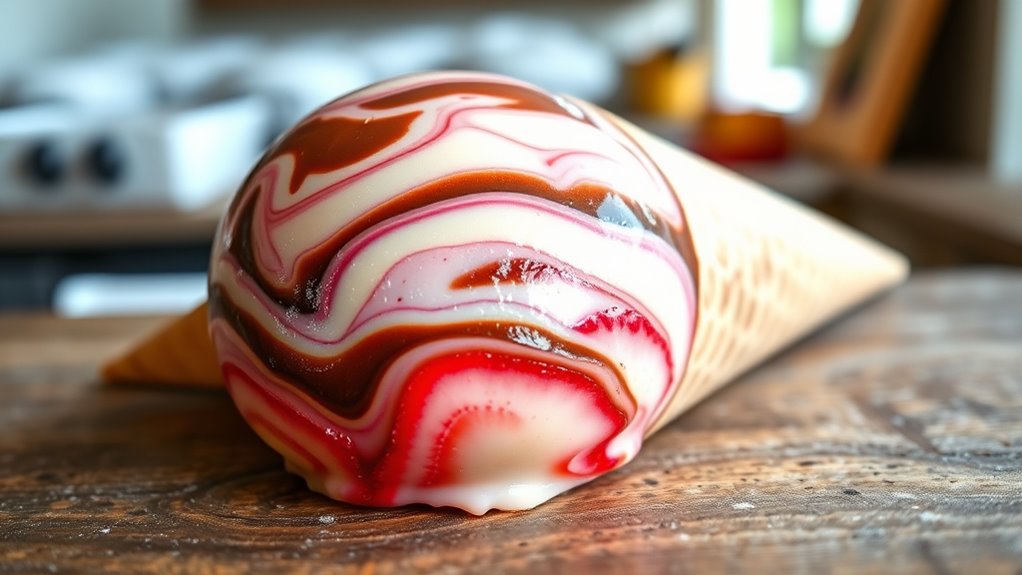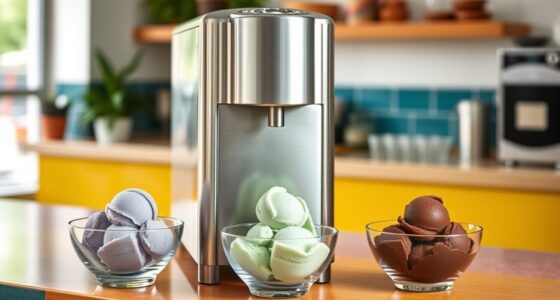Avoid overmixing your gelato, as it introduces excess air and causes icy, grainy textures. Keep a close eye on maintaining proper temperature during churning to prevent unwanted ice crystal formation. Be cautious with ingredient substitutions, ensuring they don’t compromise creaminess or cause icy results. Balance fats, sugars, and stabilizers carefully, and slow down your process for better consistency. Want to master these techniques and create perfect gelato? Keep going to learn more tips and tricks.
Key Takeaways
- Avoid overmixing during churning to prevent air pockets and a grainy, icy texture. Stop when mixture reaches soft-serve consistency.
- Maintain proper churning temperature to prevent ice crystal formation and ensure a smooth, creamy gelato.
- Properly chill ingredients before churning to support optimal freezing and prevent icy results.
- Use the correct ingredient balance, especially fats and sugars, to achieve desired creaminess and avoid icy textures.
- Follow precise techniques and patience throughout the process to ensure a dense, store-bought-like gelato.

Making gelato at home can be rewarding, but it’s easy to stumble into common mistakes that affect texture and flavor. One of the most frequent pitfalls involves overmixing during the churning process. Overmixing techniques can incorporate too much air into your gelato, resulting in a lighter, fluffier texture that isn’t true to traditional gelato’s dense consistency. To avoid this, you should churn just until the mixture reaches a soft serve-like consistency. Once it starts to thicken, resist the urge to mix further. Overmixing can also cause the gelato to become icy or grainy because excessive agitation disrupts the smooth, creamy structure you’re aiming for. Pay attention to your machine’s instructions and stop as soon as the gelato looks velvety and well combined. This simple step preserves the authentic mouthfeel and prevents unwanted air pockets that compromise flavor intensity. Additionally, maintaining proper temperature during churning prevents the formation of ice crystals, which can ruin texture.
Another common mistake involves ingredient substitutions, which can dramatically impact your gelato’s final result. When you swap ingredients, you risk altering the balance of fats, sugars, and stabilizers that give gelato its signature smoothness and richness. For example, replacing heavy cream with lower-fat dairy or plant-based alternatives might seem convenient or healthier, but it often results in a less creamy, more icy texture. Similarly, using different sweeteners can change the freezing point and mouthfeel, so it’s wise to stick to the traditional ingredients or carefully research suitable substitutes. If you must make substitutions, understand how they interact with the other components. For instance, using honey instead of sugar can introduce additional moisture, which might require adjustments in freezing time or stabilizers. Remember, each ingredient plays a specific role, and altering them without proper understanding can lead to a gelato that’s overly icy or lacking in flavor depth. Proper ingredient balance is crucial for achieving the ideal texture and flavor profile.
In both cases, patience and precision are key. Stick to recommended overmixing techniques to ensure your gelato remains smooth and dense, and be cautious with ingredient substitutions to maintain the intended texture and flavor. By paying close attention to these details, you’ll *substantially* improve your chances of making high-quality, homemade gelato that rivals store-bought varieties. It’s all about understanding how each step and ingredient influences the final product. With practice, you’ll develop a sharper eye for these common pitfalls and create gelato that’s irresistibly creamy and bursting with flavor.
Frequently Asked Questions
Can Overmixing Gelato Cause Texture Issues?
Overmixing gelato can definitely cause texture issues. When you overmix, you introduce excessive air and break down the ice crystals, leading to a less smooth and creamy consistency. This overmixing pitfall compromises texture consistency, making your gelato feel icy or grainy instead of velvety. To avoid this, mix just until the ingredients are combined, and stop before the mixture becomes too airy or overly smooth.
What’S the Ideal Storage Temperature for Homemade Gelato?
Think of your gelato as a delicate treasure. To keep it perfect, store it at a consistent -10°F to 0°F (-23°C to -18°C). This temperature range prevents freezer burn and preserves flavor. Aim to enjoy your gelato within 2-4 weeks for ideal freshness. Avoid frequent temperature fluctuations, which can cause texture issues. Proper storage duration and temperature are key to maintaining that creamy, irresistible texture you love.
How Does Sugar Affect Gelato’S Freezing Point?
Sugar lowers the gelato’s freezing point through a process called freezing point depression, preventing the formation of large ice crystals. This helps keep your gelato smooth and scoopable. However, too much sugar can cause sugar crystallization, resulting in a grainy texture. To get the perfect consistency, balance your sugar content carefully, knowing it influences both the texture and how well your gelato stays creamy during freezing.
Are There Substitutes for Traditional Stabilizers?
Think of stabilizers as the backbone of your gelato’s structure. While traditional stabilizers are common, you can explore natural thickeners like gelatin, agar-agar, or guar gum. Commercial alternatives such as xanthan gum or locust bean gum also work well. These options help prevent ice crystal formation and improve texture without relying solely on conventional stabilizers, giving you flexibility to craft creamy gelato with ingredients you trust.
How Long Should Gelato Be Churned for Best Results?
For best results, you should churn your gelato for about 20-30 minutes. During this time, maintain a consistent churning speed to guarantee smooth texture and proper flavor infusion. If you churn too little, it’ll be too soft and icy; too long, and it may become too firm. Keep an eye on the texture, and once it’s creamy and thick, it’s ready to enjoy.
Conclusion
Avoid these common mistakes, avoid ruining your gelato, and avoid disappointment. Focus on proper chilling, perfecting your technique, and maintaining consistency. When you pay attention to detail, you guarantee your gelato turns out smooth, creamy, and delicious every time. Don’t rush the process, don’t overlook the essentials, and don’t settle for less. Instead, embrace these tips, master your method, and enjoy the sweet satisfaction of flawless homemade gelato.









